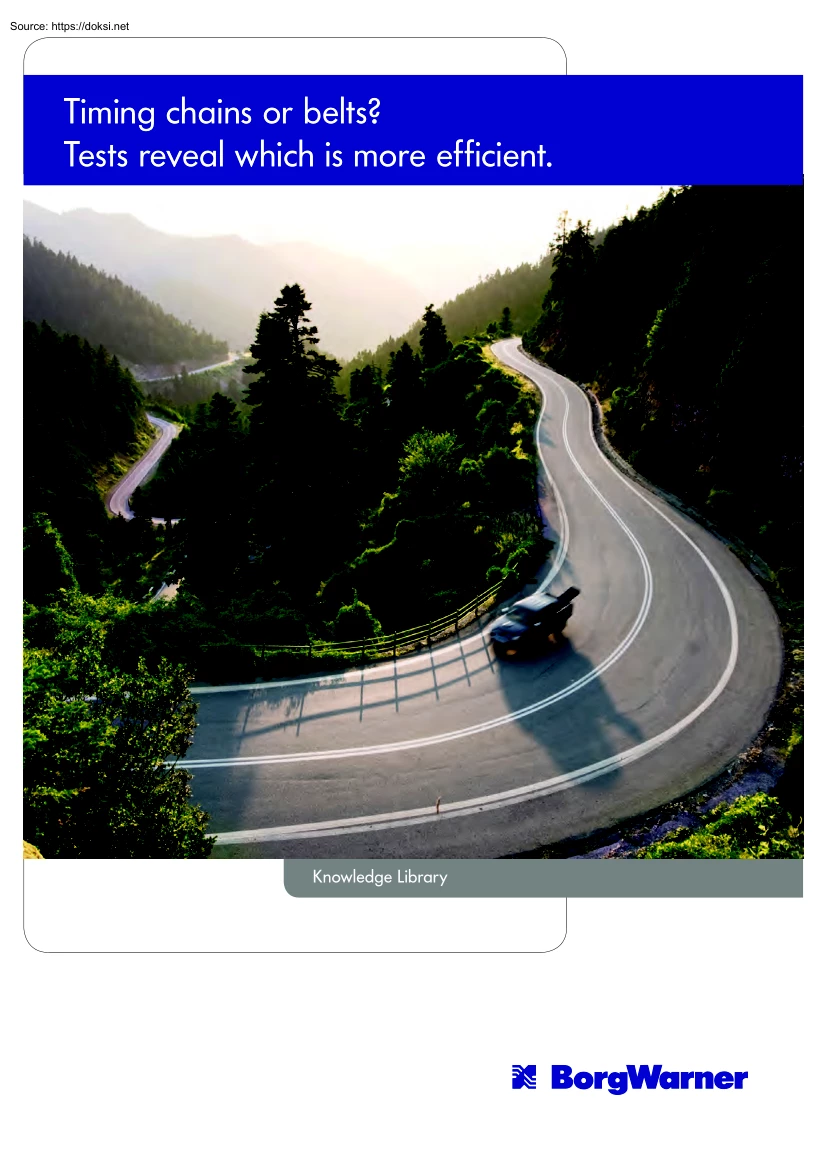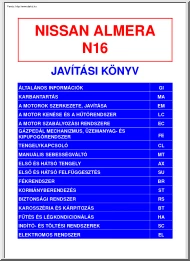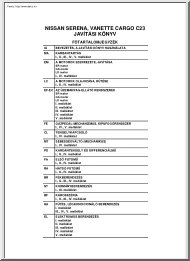Datasheet
Year, pagecount:2022, 5 page(s)
Language:English
Downloads:2
Uploaded:September 29, 2022
Size:1014 KB
Institution:
-
Comments:
Attachment:-
Download in PDF:Please log in!
Comments
No comments yet. You can be the first!Most popular documents in this category
Content extract
Timing chains or belts? Tests reveal which is more efficient. Knowledge Library whitepaper Knowledge Library.indd 1 08.0414 12:17 Knowledge Library Timing chains or belts? Tests reveal which is more efficient Timing chains or belts? The question seems as old as the automobile or internal combustion engine itself. During the past few decades, several studies have investigated which timing drive technology offers the best quality and performance. To shed some light on which type of timing drive provides more efficiency, BorgWarner conducted intensive belt and chain drive testing on a motored engine friction test stand at its technical center in Ithaca, New York. By Al Moster, Director Engineering, Borg Warner and John Goodrow, Senior Engineering Manager, BorgWarner Evaluating performance When it comes to timing drives for internal combustion engines, engine designers focus on durability, installation space in the engine compartment, NVH (noise, vibration and harshness) and
overall efficiency. With years of comparable experience on the road, chain drives offer several advantages over belts when considering a broad range of criteria. With durability lasting as long as the engine’s life, chain drives are most suitable for highpower engines. Advanced manufacturing finishes, materials and coatings improve chain strength, durability, wear resistance and efficiency. Most belt drives, on the other hand, require replacement prior to end of vehicle life In engines with limited installation space, chains offer a more compact solution. Where every millimeter of installation space counts, modern engines strongly favor chain drives over belt drives. In the cases explored in this BorgWarner Knowledge Library 201 4 study, the benefit is as much as 8-1 0 mm. However, comparing the efficiency performance between chain drives and belt drives can be more challenging. When evaluating friction, it has been claimed that belts have a natural advantage due to their design,
i.e a non-metallic belt on a metallic pulley. In many recent applications, chain manufacturers have successfully optimized chain systems to reduce friction by employing low-friction materials, optimized link geometry, tensioner tuning and advanced manufacturing techniques. Testing BorgWarner engineers set out to quantify the efficiency of chain drives and belt drives by measuring torque-to-turn at the crankshaft. In the course of the investigation, BorgWarner’s inverted tooth silent chain drive was compared with a conventional dry belt and to a wet belt operating in oil. BorgWarner’s motored engine friction test 1 stand in Ithaca, New York, allows engineers to measure the friction of the entire timing system. It consists of a non-firing engine powered by an electric motor in which the chain tensions are induced by the camshaft torques. The engines used for testing were modified to avoid variables such as fuel pump and oil pump drag, so that the friction losses associated with
belt vs. chain drive could be isolated and highly repeatable. Front and rear crank seals were also removed, and the crankshaft was neutrally balanced without the pistons and rods. BorgWarner acquired two belt driven engines, a 1 .0-liter I3 engine as well as a 1 6-liter I4 engine, and tested those engines with their original timing drives BorgWarner then developed a chain drive solution for each of these engines using an 8.0 mm pitch inverted tooth silent chain and a 6.35 mm pitch inverted tooth silent chain respectively. Results of comparative measurements As part of the chain system design process, dynamic system simulation was performed to ensure robust performance of the design. This simulation indicated that both of BorgWarner’s chain drives would be robust and will satisfy all requirements concerning chain tension and control. The test data output resulted in approximately equal timing drive torque losses between the chain drive and the wet belt drive with a good
repeatability of +/- 0.02 Nm The comparison of BorgWarner’s chain drive with a dry belt drive resulted in higher efficiency on the part of the chain system. This disadvantage of dry belts can be at least partially explained by the use of cam seals to keep the beltdry. The investigation was conducted according to the “strip method.” In this procedure, the chain or belt drive was installed on the engine, and the amount of torque needed to spin the engine at the crankshaft was measured. Then, the chain or belt was removed, and the amount of torque needed to spin the crankshaft was measured to determine the crankshaft torque. Finally, the crankshaft torque was subtracted from the total engine torque. The result revealed the timing drive and valve train torque Exhaustive build/rebuild testing was conducted to ensure test results could be repeated. Periodic retests of a baseline were also conducted The results showed test repeatability at less than 3%. BorgWarner Knowledge Library
201 4 BorgWarner’s advanced chain drive system reduces friction and weight to help improve fuel economy. 2 Timing drive valve train torque (Nm) of a chain in comparison with a dry belt. BorgWarner testing shows belts and chains offer similar efficiency performance. However, chains still feature many advantages over belts, including compact packaging, durability and better system control. What does this mean for different engine setups? Based on BorgWarner’s test results, chain and belt drives have the same or similar efficiency when the timing system is optimized. However, when choosing between chain and belt drives, the adaptability of timing drives to different engine setups is another key consideration for engine designers. Due to the higher strength-to-width ratio, chain systems featuring a hydraulic tensioner, tight strand guide and slack strand tensioner arm contain all the elements necessary for adapting to additional engine variants with minimal modifications. For
example, for one application, BorgWarner covers six different variants with a BorgWarner Knowledge Library 201 4 common chain and tensioner design. Conversely, a common dry belt features a strength-to-width ratio of less than half that of a similar chain application. When increasedpower engine variants demand higher system robustness, several factors can have a considerable effect on efficiency and engine packaging, including increased belt width, the potential need for a tight strand guide or idler pulley and increased preload due to higher amplitude inputs. Conclusion BorgWarner’s testing reveals that optimized chain and belt drives show similar efficiency. While chain drives exhibit a measurable efficiency advantage over dry belt drives, chain drives and wet belt drives perform similarly. As a result, design decisions regarding timing drives should be made by considering a number of different criteria. 3 Timing drive valve train torque (Nm) of a chain in comparison with a
wet belt. Adaptability, low dynamic cam oscillation, strength and best-in-class NVH performance make BorgWarner’s chain drives the best solution. With proven long-term field durability, BorgWarner’s chain drives offer compact packaging, optimized efficiency and robustness against dynamic instability. Contact Email: technology@borgwarner.com For more information, please visit borgwarner.com BorgWarner Knowledge Library 201 4 4
overall efficiency. With years of comparable experience on the road, chain drives offer several advantages over belts when considering a broad range of criteria. With durability lasting as long as the engine’s life, chain drives are most suitable for highpower engines. Advanced manufacturing finishes, materials and coatings improve chain strength, durability, wear resistance and efficiency. Most belt drives, on the other hand, require replacement prior to end of vehicle life In engines with limited installation space, chains offer a more compact solution. Where every millimeter of installation space counts, modern engines strongly favor chain drives over belt drives. In the cases explored in this BorgWarner Knowledge Library 201 4 study, the benefit is as much as 8-1 0 mm. However, comparing the efficiency performance between chain drives and belt drives can be more challenging. When evaluating friction, it has been claimed that belts have a natural advantage due to their design,
i.e a non-metallic belt on a metallic pulley. In many recent applications, chain manufacturers have successfully optimized chain systems to reduce friction by employing low-friction materials, optimized link geometry, tensioner tuning and advanced manufacturing techniques. Testing BorgWarner engineers set out to quantify the efficiency of chain drives and belt drives by measuring torque-to-turn at the crankshaft. In the course of the investigation, BorgWarner’s inverted tooth silent chain drive was compared with a conventional dry belt and to a wet belt operating in oil. BorgWarner’s motored engine friction test 1 stand in Ithaca, New York, allows engineers to measure the friction of the entire timing system. It consists of a non-firing engine powered by an electric motor in which the chain tensions are induced by the camshaft torques. The engines used for testing were modified to avoid variables such as fuel pump and oil pump drag, so that the friction losses associated with
belt vs. chain drive could be isolated and highly repeatable. Front and rear crank seals were also removed, and the crankshaft was neutrally balanced without the pistons and rods. BorgWarner acquired two belt driven engines, a 1 .0-liter I3 engine as well as a 1 6-liter I4 engine, and tested those engines with their original timing drives BorgWarner then developed a chain drive solution for each of these engines using an 8.0 mm pitch inverted tooth silent chain and a 6.35 mm pitch inverted tooth silent chain respectively. Results of comparative measurements As part of the chain system design process, dynamic system simulation was performed to ensure robust performance of the design. This simulation indicated that both of BorgWarner’s chain drives would be robust and will satisfy all requirements concerning chain tension and control. The test data output resulted in approximately equal timing drive torque losses between the chain drive and the wet belt drive with a good
repeatability of +/- 0.02 Nm The comparison of BorgWarner’s chain drive with a dry belt drive resulted in higher efficiency on the part of the chain system. This disadvantage of dry belts can be at least partially explained by the use of cam seals to keep the beltdry. The investigation was conducted according to the “strip method.” In this procedure, the chain or belt drive was installed on the engine, and the amount of torque needed to spin the engine at the crankshaft was measured. Then, the chain or belt was removed, and the amount of torque needed to spin the crankshaft was measured to determine the crankshaft torque. Finally, the crankshaft torque was subtracted from the total engine torque. The result revealed the timing drive and valve train torque Exhaustive build/rebuild testing was conducted to ensure test results could be repeated. Periodic retests of a baseline were also conducted The results showed test repeatability at less than 3%. BorgWarner Knowledge Library
201 4 BorgWarner’s advanced chain drive system reduces friction and weight to help improve fuel economy. 2 Timing drive valve train torque (Nm) of a chain in comparison with a dry belt. BorgWarner testing shows belts and chains offer similar efficiency performance. However, chains still feature many advantages over belts, including compact packaging, durability and better system control. What does this mean for different engine setups? Based on BorgWarner’s test results, chain and belt drives have the same or similar efficiency when the timing system is optimized. However, when choosing between chain and belt drives, the adaptability of timing drives to different engine setups is another key consideration for engine designers. Due to the higher strength-to-width ratio, chain systems featuring a hydraulic tensioner, tight strand guide and slack strand tensioner arm contain all the elements necessary for adapting to additional engine variants with minimal modifications. For
example, for one application, BorgWarner covers six different variants with a BorgWarner Knowledge Library 201 4 common chain and tensioner design. Conversely, a common dry belt features a strength-to-width ratio of less than half that of a similar chain application. When increasedpower engine variants demand higher system robustness, several factors can have a considerable effect on efficiency and engine packaging, including increased belt width, the potential need for a tight strand guide or idler pulley and increased preload due to higher amplitude inputs. Conclusion BorgWarner’s testing reveals that optimized chain and belt drives show similar efficiency. While chain drives exhibit a measurable efficiency advantage over dry belt drives, chain drives and wet belt drives perform similarly. As a result, design decisions regarding timing drives should be made by considering a number of different criteria. 3 Timing drive valve train torque (Nm) of a chain in comparison with a
wet belt. Adaptability, low dynamic cam oscillation, strength and best-in-class NVH performance make BorgWarner’s chain drives the best solution. With proven long-term field durability, BorgWarner’s chain drives offer compact packaging, optimized efficiency and robustness against dynamic instability. Contact Email: technology@borgwarner.com For more information, please visit borgwarner.com BorgWarner Knowledge Library 201 4 4





